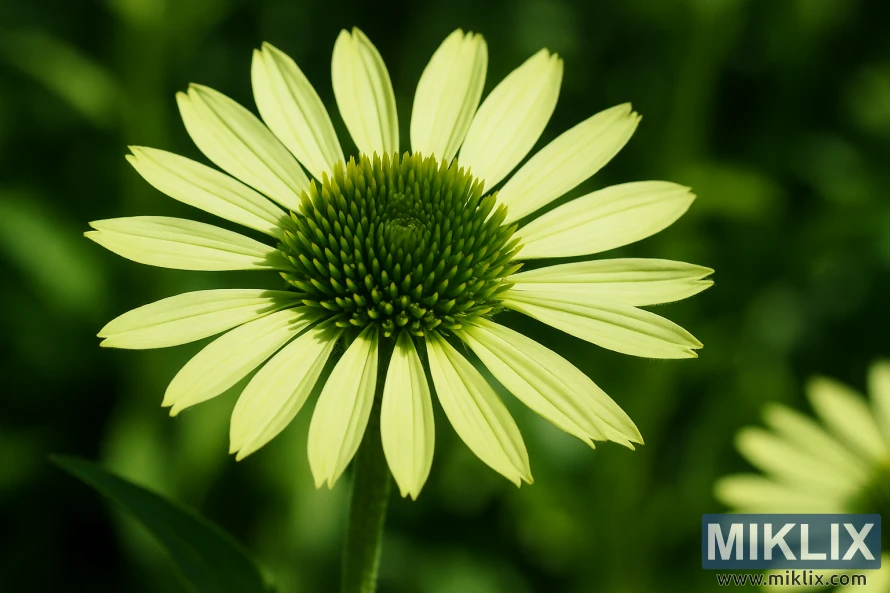Image: Close-Up of Green Jewel Coneflower in Bloom
Published: October 24, 2025 at 10:34:21 PM UTC
Detailed close-up of a Green Jewel Echinacea coneflower showcasing light green petals and a rich dark green central cone, captured in natural summer sunlight.
The image is a detailed close-up of a Green Jewel coneflower (Echinacea purpurea 'Green Jewel'), a distinctive and rare cultivar known for its unusual coloration and elegant form. Captured under bright summer sunlight, the bloom is the central focus of the composition, rendered with crisp clarity and fine detail against a softly blurred, verdant background. This photographic approach isolates the flower from its surroundings, allowing the viewer to fully appreciate its unique structure and subtle beauty.
The petals — elongated, slightly arched, and gracefully drooping — radiate symmetrically from the center in a near-perfect circle. Their color is a luminous, fresh shade of light green, delicately veined and almost translucent under the natural light. The surface of each petal exhibits a soft sheen, and faint linear striations run from base to tip, guiding the eye toward the center. Their pale hue contrasts beautifully with the deeper greens of the surrounding foliage, creating a sense of lightness and freshness that is both calming and visually striking.
At the heart of the flower lies the iconic coneflower disk — a densely packed cluster of florets forming a raised, dome-shaped cone. In Green Jewel, this cone is an intense, darker green, creating a dramatic focal point against the paler petals. The florets are arranged in a mesmerizing spiral pattern, a hallmark of Echinacea’s natural geometry. Tiny, pointed florets emerge tightly together, giving the cone a textured, almost sculptural appearance. At the very center, the green is deep and saturated, gradually transitioning to slightly lighter tones toward the outer edge — a gradient that enhances the cone’s depth and dimensionality.
Lighting plays a significant role in defining the image’s atmosphere and visual impact. The flower is bathed in soft, direct sunlight, which illuminates the petals and highlights their gentle curvature. Subtle shadows fall beneath the cone and between the petals, emphasizing the three-dimensional form and adding depth to the composition. The background — a soft blur of leafy greens — fades smoothly out of focus, providing contrast while maintaining harmony with the flower’s natural palette.
The overall impression of the photograph is one of elegance, freshness, and botanical precision. Unlike the bold, saturated colors of more traditional Echinacea varieties, Green Jewel captivates with its understated palette and refined beauty. Its tones evoke a sense of tranquility and renewal, reminiscent of spring growth even in the height of summer. This cultivar’s distinctive coloration also underscores the remarkable diversity within the Echinacea genus — a testament to nature’s capacity for variation and the art of plant breeding.
Beyond aesthetics, the image hints at the ecological significance of the flower. Like all Echinacea, Green Jewel provides valuable nectar and pollen, attracting bees, butterflies, and other pollinators to the garden. The tightly packed cone florets, though visually striking, are also functional — each one a potential feeding site and part of the plant’s reproductive cycle.
Altogether, this image celebrates the beauty of subtlety in the plant world. The Green Jewel coneflower’s unique green-on-green palette, precise symmetry, and sculptural form make it a standout in any garden, and here, those qualities are captured in exquisite photographic detail — a portrait of natural elegance at its peak.
The image is related to: 12 Beautiful Coneflower Varieties to Transform Your Garden

